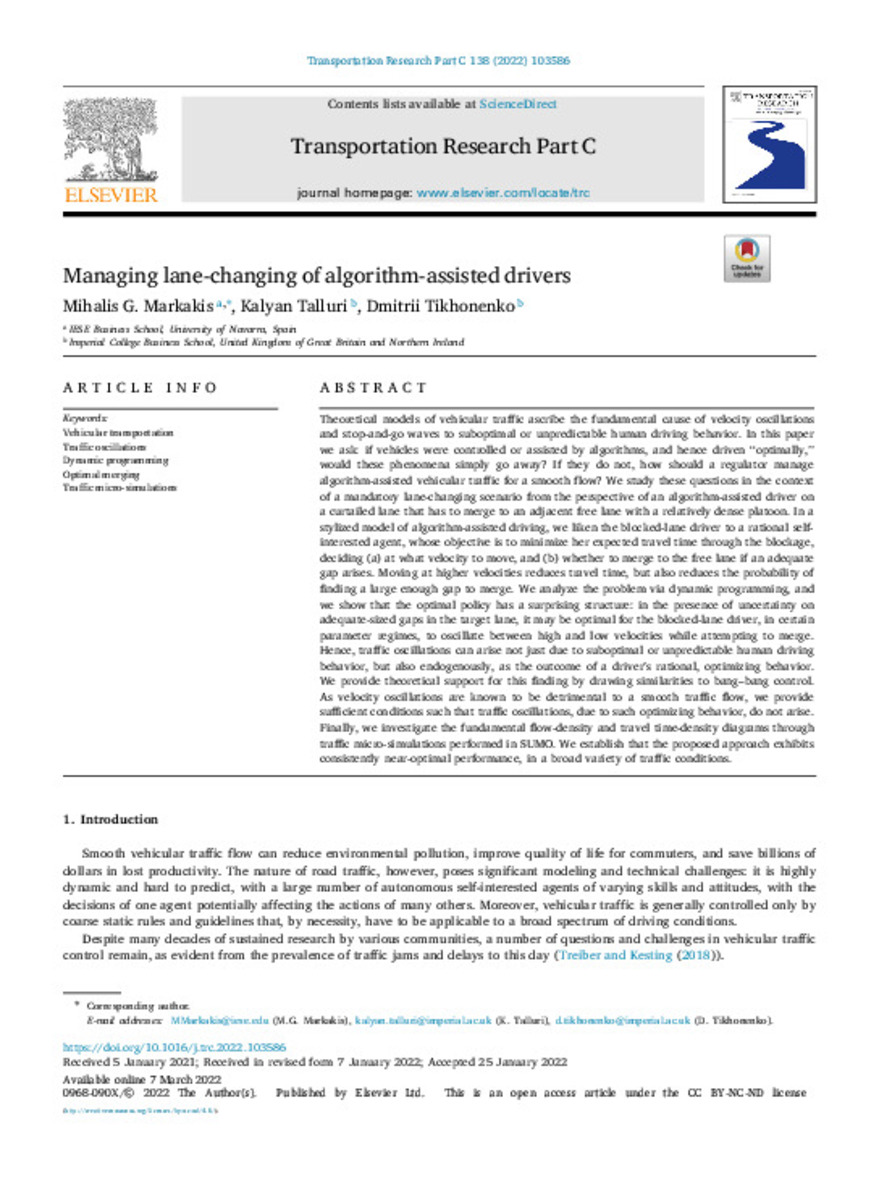Full metadata record
| DC Field | Value | Language |
|---|---|---|
| dc.creator | Markakis, M.G. (Mihalis G.) | - |
| dc.creator | Tallur, K. (Kalyan) | - |
| dc.creator | Tikhonenko, D. (Dmitrii) | - |
| dc.date.accessioned | 2022-03-11T13:41:21Z | - |
| dc.date.available | 2022-03-11T13:41:21Z | - |
| dc.date.issued | 2022-03-07 | - |
| dc.identifier.citation | Markakis, M.G. (Mihalis G.); Tallur, K. (Kalyan); Tikhonenko, D. (Dmitrii). "Managing lane-changing of algorithm-assisted drivers". Transportation Research Part C: Emerging Technologies. 138, 2022-03-07, 103586 | es |
| dc.identifier.issn | 0968-090X | - |
| dc.identifier.uri | https://hdl.handle.net/10171/63145 | - |
| dc.description.abstract | Theoretical models of vehicular traffic ascribe the fundamental cause of velocity oscillations and stop-and-go waves to suboptimal or unpredictable human driving behavior. In this paper we ask: if vehicles were controlled or assisted by algorithms, and hence driven “optimally,” would these phenomena simply go away? If they do not, how should a regulator manage algorithm-assisted vehicular traffic for a smooth flow? We study these questions in the context of a mandatory lane-changing scenario from the perspective of an algorithm-assisted driver on a curtailed lane that has to merge to an adjacent free lane with a relatively dense platoon. In a stylized model of algorithm-assisted driving, we liken the blocked-lane driver to a rational self-interested agent, whose objective is to minimize her expected travel time through the blockage, deciding (a) at what velocity to move, and (b) whether to merge to the free lane if an adequate gap arises. Moving at higher velocities reduces travel time, but also reduces the probability of finding a large enough gap to merge. We analyze the problem via dynamic programming, and we show that the optimal policy has a surprising structure: in the presence of uncertainty on adequate-sized gaps in the target lane, it may be optimal for the blocked-lane driver, in certain parameter regimes, to oscillate between high and low velocities while attempting to merge. Hence, traffic oscillations can arise not just due to suboptimal or unpredictable human driving behavior, but also endogenously, as the outcome of a driver’s rational, optimizing behavior. We provide theoretical support for this finding by drawing similarities to bang–bang control. As velocity oscillations are known to be detrimental to a smooth traffic flow, we provide sufficient conditions such that traffic oscillations, due to such optimizing behavior, do not arise. Finally, we investigate the fundamental flow-density and travel time-density diagrams through traffic micro-simulations performed in SUMO. We establish that the proposed approach exhibits consistently near-optimal performance, in a broad variety of traffic conditions. | es_ES |
| dc.description.sponsorship | This work was supported by the ECO2013-41131-R and ECO2016-75905-R (AEI/FEDER, UE, Spain) grants, as well as a Juan de la Cierva fellowship, from the Spanish Ministry of Economy and Competitiveness. M.G. Markakis was also supported by the Spanish Ministry of Science and Innovation through a Ramón y Cajal fellowship, Spain . | es_ES |
| dc.language.iso | eng | es_ES |
| dc.publisher | Elsevier | es_ES |
| dc.rights | info:eu-repo/semantics/openAccess | es_ES |
| dc.subject | Vehicular transportation | es_ES |
| dc.subject | Traffic oscillations | es_ES |
| dc.subject | Dynamic programming | es_ES |
| dc.subject | Optimal merging | es_ES |
| dc.subject | Traffic micro-simulations | es_ES |
| dc.title | Managing lane-changing of algorithm-assisted drivers | es_ES |
| dc.type | info:eu-repo/semantics/article | es_ES |
| dc.publisher.place | United States of America | es_ES |
| dc.description.note | This is an open access article under the CC BY-NC-ND license | es_ES |
| dc.identifier.doi | 10.1016/j.trc.2022.103586 | - |
| dadun.citation.publicationName | Transportation Research Part C: Emerging Technologies | es_ES |
| dadun.citation.startingPage | 103586 | es_ES |
| dadun.citation.volume | 138 | es_ES |
Files in This Item:
Statistics and impact
Items in Dadun are protected by copyright, with all rights reserved, unless otherwise indicated.






